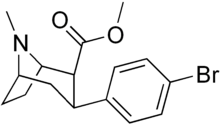RTI-51
RTI-51 | |
| 식별자 | |
|---|---|
| |
| CAS 번호 | |
| 펍켐 CID | |
| CompTox 대시보드 (EPA) | |
| 화학 및 물리적 데이터 | |
| 공식 | C16H20BRNO2 |
| 어금질량 | 338.168 g·messages−1 |
| 3D 모델(JSmol) | |
| |
| |
| | |
(–--2β-카르보메트호xy-3β-(4-브로모페닐)트로판(RTI-4229-51, 브로모판)은 정신안정제 화합물의 페닐트로판 그룹에 있는 반합성 알칼로이드다.1990년대에 처음 공개된 이 책은 완전히 확립된 프로필을 얻을 만큼 충분히 사용되지 않았다.RTI-51은 RTI-31과 RTI-55 사이에 속성이 있을 것으로 예상할 수 있다.중요한 것은, 모노아민 재흡수 억제 비율을 D > S > N (각각 1.8:10.6:37.4nM)으로 하고 있는데, 이는 일반적으로 사용되는 다른 화합물에서 생성되지 않은 효과의 특이한 균형이다(RTI-121은 유사하지만 DAT 선택성이 더 높다).[1]그것은 뇌에서 도파민 전달체의 분포를 지도하기 위해 Br radiolabelated 형태로 사용되어 왔다.[2]
| 할로겐 | 원자 № | 원자량 | EN | 본드 길이 |
| 플루오린 | 9 | 19.0 | 4.0 | |
| 염소 | 17 | 35.5 | 3.2 | |
| 브로민 | 35 | 79.9 | 3.0 | |
| 요오드 | 53 | 127 | 2.7 |
현대의 연구는 위의 가설을 확증하는 것 같다.[3]그러나, 이전의 작업은 더 많은 분산된 결과를 낳았다.[4]표에서 볼 때, RTI-31, RTI-51 및 RTI-55는 모두 유사하게 강력한 TRI이다.[5][6]
| MAT IC50(및 Ki)는 1R,2S,3S 입체화학성을 가진 단순한 페닐트로판이다.[7] | ||||||
| 화합물 | [3H]CFT | [3H]DA | [3H]니소세틴 | [3H]NE | [3H]파록세틴 | [3H]5-HT |
| 코카인[8] | 89.1 | 275 cf 241 | 3300 (1990) | 119cf.11 | 1050 (45) | 177 cf 112 |
| WIN 35,065-2 | 23 | 49.8 | 920 (550) | 37.2 | 1960 (178) | 173 |
| WIN 35,428 | 13.9 | 23.0 | 835 (503) | 38.6 | 692 (63) | 101 |
| RTI-31 | 1.1 | 3.68 | 37 (22) | 5.86 | 44.5 (4.0) | 5.00 |
| RTI-113[9] | 1.98 | 5.25 | 2,926 | 242 | 2,340 | 391 |
| RTI-51 | 1.7 | ? | 37.4 (23) | ? | 10.6 (0.96) | ? |
| RTI-55 | 1.3 | 1.96 | 36 (22) | 7.51 | 4.21 (0.38) | 1.74 |
| RTI-32 | 1.7 | 7.02 | 60 (36) | 8.42 | 240 (23) | 19.4 |
위 표의 데이터: 쥐의 두뇌(1995)더 최근의 연구는 복제된 인간 수송기를 사용하는 것을 주장해왔다.
참고 항목
참조
- ^ Singh S (March 2000). "Chemistry, design, and structure-activity relationship of cocaine antagonists". Chemical Reviews. 100 (3): 925–1024. doi:10.1021/cr9700538. PMID 11749256.
- ^ 로치 C, 뮐러 L, 오타비아니 M, 할딘 C, 파르드 L, 마지레 B.도파민 흡수 부위의 생체내 영상 촬영을 위한 PET 추적기인 2β-카르보메톡시-3β-(4-[76Br]브로모페닐) 트로판의 합성.라벨 부착 화합물 및 방사선 의약품 저널 1995; 36(4):385-392.
- ^ Wee S, Carroll FI, Woolverton WL (February 2006). "A reduced rate of in vivo dopamine transporter binding is associated with lower relative reinforcing efficacy of stimulants". Neuropsychopharmacology. 31 (2): 351–62. doi:10.1038/sj.npp.1300795. PMID 15957006. S2CID 7224342.
- ^ Stathis M, Scheffel U, Lever SZ, Boja JW, Carroll FI, Kuhar MJ (June 1995). "Rate of binding of various inhibitors at the dopamine transporter in vivo". Psychopharmacology. 119 (4): 376–84. doi:10.1007/BF02245852. PMID 7480516. S2CID 20022021.
- ^ Kimmel HL, Carroll FI, Kuhar MJ (December 2001). "Locomotor stimulant effects of novel phenyltropanes in the mouse". Drug and Alcohol Dependence. 65 (1): 25–36. doi:10.1016/S0376-8716(01)00144-2. PMID 11714587.
- ^ Kuhar MJ, Carroll FI, Bharat N, Landry DW (August 2001). "Anticocaine catalytic antibodies have no affinity for RTI compounds: implications for treatment". Synapse. 41 (2): 176–8. doi:10.1002/syn.1072. PMID 11400184. S2CID 11862673.
- ^ Carroll FI, Kotian P, Dehghani A, Gray JL, Kuzemko MA, Parham KA, et al. (January 1995). "Cocaine and 3 beta-(4'-substituted phenyl)tropane-2 beta-carboxylic acid ester and amide analogues. New high-affinity and selective compounds for the dopamine transporter". Journal of Medicinal Chemistry. 38 (2): 379–88. doi:10.1021/jm00002a020. PMID 7830281.
- ^ Kozikowski AP, Johnson KM, Deschaux O, Bandyopadhyay BC, Araldi GL, Carmona G, et al. (April 2003). "Mixed cocaine agonist/antagonist properties of (+)-methyl 4beta-(4-chlorophenyl)-1-methylpiperidine-3alpha-carboxylate, a piperidine-based analog of cocaine". The Journal of Pharmacology and Experimental Therapeutics. 305 (1): 143–50. doi:10.1124/jpet.102.046318. PMID 12649362. S2CID 29377097.
- ^ Damaj MI, Slemmer JE, Carroll FI, Martin BR (June 1999). "Pharmacological characterization of nicotine's interaction with cocaine and cocaine analogs". The Journal of Pharmacology and Experimental Therapeutics. 289 (3): 1229–36. PMID 10336510.


